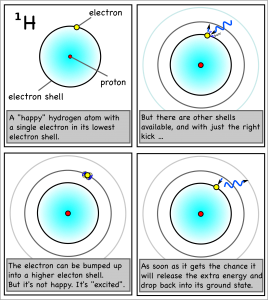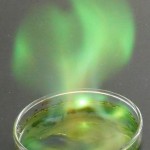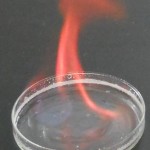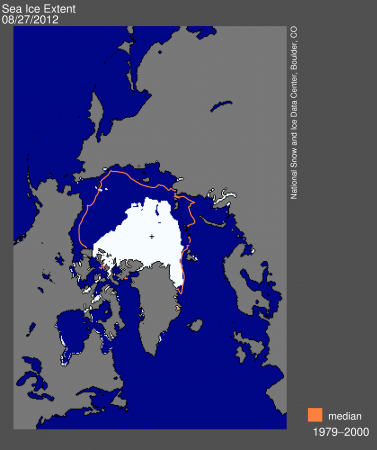A really neat take on a Rube Goldberg machine by 2D House:
Category: Physics
Indoor Clouds
Berndnaut Smilde generates and photographs clouds inside buildings, “He uses a fog machine and carefully adjusts the temperature and humidity to produce clouds just long enough to photograph.”
Flame Tests

Elements can be identified from the color of light they give off when they’re ionized: their emission spectra. Ms. Wilson’s chemistry class today set fire to some metal salts to watch them burn.

She placed the salt crystals into petri dishes, submerged them in a shallow layer of alcohol, and ignited the alcohol. As traces of the salts were incorporated into the flames, the metal atoms became “excited” as they absorbed some of the energy from the flame by bumping up their electrons into higher electron shells. Since atoms don’t “like” to be excited, their excited electrons quickly dropped back to their stable, ground state, but, in doing so, released the excess energy as light of the characteristic wavelength.
Table 1: Emission colors of different metals.
| Metal | Flame |
|---|---|
| Copper |  |
| Strontium |  |
Sodium |  |
Lithium |  |
Ice-Albedo: A not-so-Positive Feedback
This summer’s arctic ice cap is the smallest since we’ve started watching it from space in the 1970’s, and the summer isn’t over yet.
Over the last few years, the rate at which the ice is melting is accelerating, probably due to the ice-albedo feedback. Albedo refers to how reflective a surface is; the average of the Earth is about 31%, while snow and ice has an albedo closer to 90%.
When the albedo is high, a lot of sunlight is reflected back into space, but when it’s lowered, such as when the sea-ice melts, the surface absorbs a lot more sunlight, which heats it up. Of course, more heat melts more ice which further decreases the albedo which causes more warming which melts more ice …. And you can see the problem.
The ice albedo feedback takes a small change (melting ice) and accelerates it. That’s a positive feedback, although the effects are usually not what you want, because they take the system (the Earth’s climate in this case) away from it’s current equilibrium. This is not to say that there are no benefits; the Northwest Passage will open up eventually, if it has not already.

↬ ClimateCentral.org ᔥ the NSIDC
Bending a Soccer Ball
Students from the University of Leicester have published a beautiful short research paper (pdf) on the physics of curving a soccer ball through the air.
It has been found that the amount a football bends depends linearly on the speed of the ball and the amount of spin.
— Sandhu et al., 2011: How to score a goal (pdf) in the University of Leicester’s Journal of Physics Special Topics
They derive the relationship from Bernoulli’s equation using some pretty straightforward algebra. The force (F) perpendicular to the ball’s motion that causes it to curl is:
![]()
and the distance the ball curls can be calculated from:
![]()
where:
- F = force perpendicular to the direction the ball is kicked
- D = perpendicular distance the ball moves to the direction it is kicked (the amount of curl)
- R = radius of the ball
- ρ = density of the air
- ω = angular velocity of the ball
- v = velocity of the ball (in the direction it is kicked)
- m = mass of the ball
- x = distance traveled in the direction the ball is kicked
The paper itself is an excellent example of what a short, student research paper should look like. And there are number of neat followup projects that advanced, high-school, physics/calculus students could take on, such as: considering the vertical dimension — how much time it take for the ball to rise and fall over the wall; creating a model (VPython) of the motion of the ball; and adding in the slowing of the ball due to air friction.
The Physics of How Microwaves Work
An excellent explanation of how microwaves work. It talks about waves (how to determine the frequency and wavelength of microwaves), electricity (magnetrons), heat and temperature.
Resonance Frequencies: MythBusters investigate Tesla’s Earthquake Machine
The whole episode is worth watching, but this little section (at 10:52) of MythBusters’ attempt to build an earthquake machine there demonstrate the resonance frequency in a water tank provides a nice visualization.
Landing the Mars Rover: 7 Minutes of Terror
NASA gets dramatic. But the drama is oh so appropriate when you see what they have to do to land a rover on Mars. There are so many steps to the landing — heat shields, atmospheric friction, parachute, rockets — that it’ll be amazing if it works, and the video is a wonderful “strike the imagination” introduction to the physics of forces.